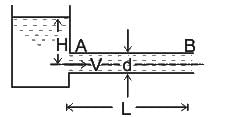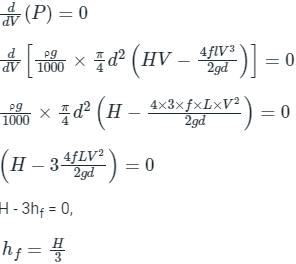Civil Engineering (CE) Exam > Civil Engineering (CE) Questions > The power transmitted through a pipe is maxim...
Start Learning for Free
The power transmitted through a pipe is maximum when the loss of head due to friction is given by (H = head supplied)
- a)H/4
- b)H/3
- c)H/2
- d)2H/3
Correct answer is option 'B'. Can you explain this answer?
Verified Answer
The power transmitted through a pipe is maximum when the loss of head ...
The power transmitted through a pipe is maximum when the loss of head due to friction is given by (H = head supplied),
hf = H/3
Power transmission through pipes:
hf = H/3
Power transmission through pipes:
- Power is transmitted through pipes by flowing water or other liquids through them.
- Power transmitted through pipes will be dependent over the following factors as mentioned here.
- Rate of flow through the pipe.
- Total head available at the end of the pipe
Now we will consider a tank with which a pipe AB is connected. Let us consider the following terms from figure

L = Length of the pipe, D = Diameter of the pipe, H = Total head available at the inlet of the pipe, V= Velocity of flow in the pipe, hf = Loss of head due to friction, f = Co-efficient of friction
Power transmitted at the outlet of the pipe can be determined by:
P = γQHnet

Condition for maximum transmission of power:
Now we will find here the condition for maximum transmission of power and it could be secured by differentiating the equation of power transmitted at the outlet of the pipe.


L = Length of the pipe, D = Diameter of the pipe, H = Total head available at the inlet of the pipe, V= Velocity of flow in the pipe, hf = Loss of head due to friction, f = Co-efficient of friction
Power transmitted at the outlet of the pipe can be determined by:
P = γQHnet

Condition for maximum transmission of power:
Now we will find here the condition for maximum transmission of power and it could be secured by differentiating the equation of power transmitted at the outlet of the pipe.

Most Upvoted Answer
The power transmitted through a pipe is maximum when the loss of head ...
The power transmitted through a pipe is maximum when the loss of head due to friction is given by (H = head supplied),
hf = H/3
Power transmission through pipes:
hf = H/3
Power transmission through pipes:
- Power is transmitted through pipes by flowing water or other liquids through them.
- Power transmitted through pipes will be dependent over the following factors as mentioned here.
- Rate of flow through the pipe.
- Total head available at the end of the pipe
Now we will consider a tank with which a pipe AB is connected. Let us consider the following terms from figure

L = Length of the pipe, D = Diameter of the pipe, H = Total head available at the inlet of the pipe, V= Velocity of flow in the pipe, hf = Loss of head due to friction, f = Co-efficient of friction
Power transmitted at the outlet of the pipe can be determined by:
P = γQHnet

Condition for maximum transmission of power:
Now we will find here the condition for maximum transmission of power and it could be secured by differentiating the equation of power transmitted at the outlet of the pipe.


L = Length of the pipe, D = Diameter of the pipe, H = Total head available at the inlet of the pipe, V= Velocity of flow in the pipe, hf = Loss of head due to friction, f = Co-efficient of friction
Power transmitted at the outlet of the pipe can be determined by:
P = γQHnet

Condition for maximum transmission of power:
Now we will find here the condition for maximum transmission of power and it could be secured by differentiating the equation of power transmitted at the outlet of the pipe.

Free Test
FREE
| Start Free Test |
Community Answer
The power transmitted through a pipe is maximum when the loss of head ...
Explanation:
When fluid flows through a pipe, there is a loss of head due to friction between the fluid and the pipe walls. This loss of head is represented by the variable H.
The power transmitted through a pipe can be calculated using the formula:
P = (Q × H × ρ × g) / η
Where:
P = Power transmitted (W)
Q = Flow rate of fluid (m^3/s)
H = Loss of head due to friction (m)
ρ = Density of fluid (kg/m^3)
g = Acceleration due to gravity (m/s^2)
η = Efficiency of the system
Derivation:
To determine the maximum power transmitted through the pipe, we need to find the maximum value of H.
To do this, let's differentiate the power equation with respect to H and equate it to zero to find the critical point:
dP/dH = (Q × ρ × g) / η - (Q × H × ρ × g) / η^2 = 0
This equation simplifies to:
H = η
This critical point indicates that the power transmitted is maximum when the loss of head due to friction is equal to the efficiency of the system (H = η).
Answer:
Therefore, when H = η, the power transmitted through the pipe is maximum. In terms of the head supplied (H), this can be written as H/3, which corresponds to option 'B'.
When fluid flows through a pipe, there is a loss of head due to friction between the fluid and the pipe walls. This loss of head is represented by the variable H.
The power transmitted through a pipe can be calculated using the formula:
P = (Q × H × ρ × g) / η
Where:
P = Power transmitted (W)
Q = Flow rate of fluid (m^3/s)
H = Loss of head due to friction (m)
ρ = Density of fluid (kg/m^3)
g = Acceleration due to gravity (m/s^2)
η = Efficiency of the system
Derivation:
To determine the maximum power transmitted through the pipe, we need to find the maximum value of H.
To do this, let's differentiate the power equation with respect to H and equate it to zero to find the critical point:
dP/dH = (Q × ρ × g) / η - (Q × H × ρ × g) / η^2 = 0
This equation simplifies to:
H = η
This critical point indicates that the power transmitted is maximum when the loss of head due to friction is equal to the efficiency of the system (H = η).
Answer:
Therefore, when H = η, the power transmitted through the pipe is maximum. In terms of the head supplied (H), this can be written as H/3, which corresponds to option 'B'.

|
Explore Courses for Civil Engineering (CE) exam
|

|
Question Description
The power transmitted through a pipe is maximum when the loss of head due to friction is given by (H = head supplied)a)H/4b)H/3c)H/2d)2H/3Correct answer is option 'B'. Can you explain this answer? for Civil Engineering (CE) 2025 is part of Civil Engineering (CE) preparation. The Question and answers have been prepared according to the Civil Engineering (CE) exam syllabus. Information about The power transmitted through a pipe is maximum when the loss of head due to friction is given by (H = head supplied)a)H/4b)H/3c)H/2d)2H/3Correct answer is option 'B'. Can you explain this answer? covers all topics & solutions for Civil Engineering (CE) 2025 Exam. Find important definitions, questions, meanings, examples, exercises and tests below for The power transmitted through a pipe is maximum when the loss of head due to friction is given by (H = head supplied)a)H/4b)H/3c)H/2d)2H/3Correct answer is option 'B'. Can you explain this answer?.
The power transmitted through a pipe is maximum when the loss of head due to friction is given by (H = head supplied)a)H/4b)H/3c)H/2d)2H/3Correct answer is option 'B'. Can you explain this answer? for Civil Engineering (CE) 2025 is part of Civil Engineering (CE) preparation. The Question and answers have been prepared according to the Civil Engineering (CE) exam syllabus. Information about The power transmitted through a pipe is maximum when the loss of head due to friction is given by (H = head supplied)a)H/4b)H/3c)H/2d)2H/3Correct answer is option 'B'. Can you explain this answer? covers all topics & solutions for Civil Engineering (CE) 2025 Exam. Find important definitions, questions, meanings, examples, exercises and tests below for The power transmitted through a pipe is maximum when the loss of head due to friction is given by (H = head supplied)a)H/4b)H/3c)H/2d)2H/3Correct answer is option 'B'. Can you explain this answer?.
Solutions for The power transmitted through a pipe is maximum when the loss of head due to friction is given by (H = head supplied)a)H/4b)H/3c)H/2d)2H/3Correct answer is option 'B'. Can you explain this answer? in English & in Hindi are available as part of our courses for Civil Engineering (CE).
Download more important topics, notes, lectures and mock test series for Civil Engineering (CE) Exam by signing up for free.
Here you can find the meaning of The power transmitted through a pipe is maximum when the loss of head due to friction is given by (H = head supplied)a)H/4b)H/3c)H/2d)2H/3Correct answer is option 'B'. Can you explain this answer? defined & explained in the simplest way possible. Besides giving the explanation of
The power transmitted through a pipe is maximum when the loss of head due to friction is given by (H = head supplied)a)H/4b)H/3c)H/2d)2H/3Correct answer is option 'B'. Can you explain this answer?, a detailed solution for The power transmitted through a pipe is maximum when the loss of head due to friction is given by (H = head supplied)a)H/4b)H/3c)H/2d)2H/3Correct answer is option 'B'. Can you explain this answer? has been provided alongside types of The power transmitted through a pipe is maximum when the loss of head due to friction is given by (H = head supplied)a)H/4b)H/3c)H/2d)2H/3Correct answer is option 'B'. Can you explain this answer? theory, EduRev gives you an
ample number of questions to practice The power transmitted through a pipe is maximum when the loss of head due to friction is given by (H = head supplied)a)H/4b)H/3c)H/2d)2H/3Correct answer is option 'B'. Can you explain this answer? tests, examples and also practice Civil Engineering (CE) tests.

|
Explore Courses for Civil Engineering (CE) exam
|

|
Signup for Free!
Signup to see your scores go up within 7 days! Learn & Practice with 1000+ FREE Notes, Videos & Tests.


















